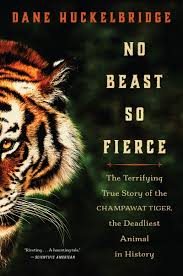Tiger of terror…
Author: Dane Huckelbridge
 It was a reign of terror like no other. Injured by a hunter and unable to capture her usual prey, she started hunting, killing and eating humans around the year 1900 in western Nepal. Averaging about one kill a week, she would go on to kill an estimated 436 individuals in both Nepal and India before she was finally stopped. Known as the Champawat Tiger, she still reigns as the deadliest animal in human history. Often in vividly dreadful detail, journalist Dane Huckelbridge tells her frightening true story in No Beast So Fierce.
It was a reign of terror like no other. Injured by a hunter and unable to capture her usual prey, she started hunting, killing and eating humans around the year 1900 in western Nepal. Averaging about one kill a week, she would go on to kill an estimated 436 individuals in both Nepal and India before she was finally stopped. Known as the Champawat Tiger, she still reigns as the deadliest animal in human history. Often in vividly dreadful detail, journalist Dane Huckelbridge tells her frightening true story in No Beast So Fierce.
Much as you might tell the tale of a serial killer, the author follows the cat from the jungles of western Nepal into the Himalayan foothills where she would go on to terrorize town after town. He also presents plenty of the necessary backstory, outlining how British colonial policy allowed the tiger to continue her depredations for years with very little resistance. Most impressively, Huckelbridge does a remarkable job getting into the head of the perpetrator – like a criminal profiler – explaining why she made many of the decisions she made. He then goes on to tell the story Jim Corbett, the man who seemed destined to stop her.
I don’t think that most modern day Americans can really fathom what it must have been like to be a poor Nepali or Indian peasant – working hard every day to wrest a livelihood from the soil, collect water from the local stream or gather food items in the woods – living with the very real possibility that at any moment a hungry 500 pound tiger could leap out of the woods and instantly kill you. Throughout the book, the author does an impressive job of capturing the paralyzing fear that these unfortunate people lived and died with every day. After a kill, villagers would often shut themselves away in their homes for days, hoping the tiger would eventually move on to terrorize some other town.
As I read this compelling and terrifying story, I couldn’t help but be reminded of another serial killer I’d recently read about. While The Man from the Train used an ax to terrorize dozens of small towns across North America, rather than teeth and claws in Asia, he was active during the very same decade and had a similarly unstoppable modus operandi. The parallels are actually sort of eerie at times.
Equal parts horror and history, No Beast So Fierce is simply one incredible read. But there’s more! Huckelbridge also investigates the status of the Champawat Tiger’s modern day compatriots. While most of the tigers that roam Asia’s last remaining jungles today aren’t eating humans, they do face numerous obstacles that may impact their ability to survive into the future. Highly recommended for anyone interested in a different kind of true crime story.
— D. Driftless
Champawat photo by Yogesh Rawat (CC BY-SA 3.0)/tiger photo by Seemaleena (CC BY-SA 4.0)
Check out Dave’s reviews of other books about animals deadly and dangerous: American Wolf / America’s Snake / The Book of Deadly Animals
[AMAZONPRODUCTS asin=”0062678841″]
- Best Non-Fiction of 2016 - February 1, 2017
- Little Free Library Series — Savannah - May 22, 2015
- Little Free Library Series — Wyoming - November 30, 2014



